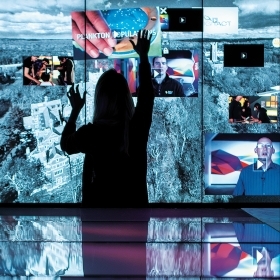For centuries, humans have looked into the cosmos, using light to unlock the mysteries of the universe. A century ago, Albert Einstein gave humanity a new way of looking at the universe: his general theory of relativity. That theory suggested a way of listening to the universe as well: gravitational waves, or “ripples in the fabric of space-time,” as scientists call them.
Nergis Mavalvala ’90, Curtis and Kathleen Marble Professor of Astrophysics at MIT, is one of the people who is listening. She’s part of a collaboration of nearly 1,000 university researchers around the world who seek to observe gravitational waves directly, which has never before been done.
Their tool in this enterprise is the Laser Interferometer Gravitational Observatory (LIGO). It comprises two sites, near Hanford, Wash., and near Baton Rouge, La. Each detector is L-shaped with each “arm” of the L extending 2.5 miles. At each site, a device called an interferometer measures the time it takes for beams of laser light to travel a prescribed trajectory between carefully calibrated mirrors.
As a gravitational wave from the distant universe passes through the detector, it changes space-time distances, making them longer and shorter several times per second. Because the speed of light is constant, a change in travel time of the laser beam measures a change in distance (space).
With two sites, researchers can control for false signals and, when they do capture matching data signatures at the two sites, they can triangulate to determine what direction in the universe (literally) the signal is coming from.
“Gravitational waves were an essential part of Einstein’s theory of general relativity,” explains Nergis, who received a MacArthur “genius” fellowship in 2010. “Newton taught us that gravity is a force. Einstein said you can think of gravity as geometry, arising because massive objects change the curvature of space-time.”
A stone plunked into the middle of a still pond creates ripples that may spread to the water’s edge and may rock a child’s toy boat. Likewise, the collision of two black holes, for instance, sets off gravitational waves that the researchers of the LIGO Scientific Collaboration expect will ripple all the way to their observatory.
The observatories just had a significant upgrade. The new Advanced LIGO detectors came online in September 2015, and are to be fully operational by 2018, when they will be 10 times more sensitive than the previous generation of detectors.
Gravitational waves have clearly captured Nergis’s imagination as a way to study the universe. She offers a helpful metaphor: An introvert leaves a party by saying good-bye to the host and slipping away quickly. An extrovert says good-bye to everyone and takes forever to leave.
Light, in this analogy, is the extrovert—“extremely garrulous, has to speak to every electron on the way out,” Nergis says. As a result, the first light did not escape the hot, dense early universe until nearly 400,000 years after the Big Bang. But gravitational waves, more “aloof” from their surroundings, in Nergis’s analogy, began to emerge from the nascent universe within a tiny fraction of a second of the Big Bang.
That means gravitational waves can help scientists go back much farther in time in their study of the cosmos. “We still don’t know what happened in those first 400,000 years,” says Nergis, and she adds that, for her personally, exploring those earliest years of the universe “is perhaps the most exciting thing to do with these gravitational waves.”
Gravitational waves are also a promising tool for the study of black holes, where, by definition, there is no light. When black holes crash into each other, they emit a cacophony of gravitational waves.
Advanced LIGO will allow scientists to “listen” to these dark and violent events in the universe. Objects like black holes and pulsars orbiting each other can radiate gravitational waves at frequencies of hundreds of hertz (cycles per second). These frequencies, when encoded as sound, are “within the human audio band,” Nergis explains. “These are the sounds of the universe.” Until now, astronomers have used their eyes to study the cosmos. “We have not been able to put our ears to the problem. … This will show us things we haven’t even imagined.”
[Editor’s Note: Just after the print edition of Wellesley went to press, it was announced that the LIGO team had detected gravitational waves resulting from the collision of two black holes and had recorded the resulting sound. Click here for more information.]







We ask that those who engage in Wellesley magazine's online community act with honesty, integrity, and respect. (Remember the honor code, alums?) We reserve the right to remove comments by impersonators or comments that are not civil and relevant to the subject at hand. By posting here, you are permitting Wellesley magazine to edit and republish your comment in all media. Please remember that all posts are public.